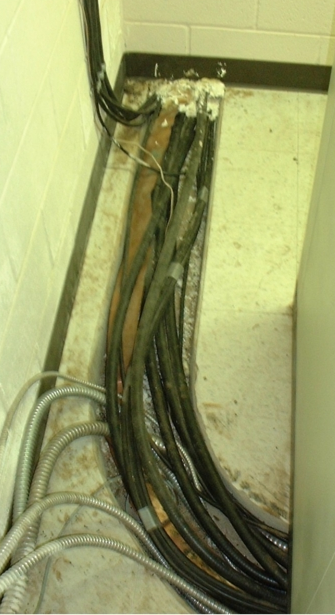
Before they threw me to the ground and put this sales shirt on me, many of you will know I spent 16.5 years as a Nautel Customer Service Engineer. That adds up to a lot of years in the field, and a whole lot of time at various transmitter sites speaking to thousands of customers… that would be you folks out there every day putting music on the ether.
My contributions to the Tips ‘n Tricks column will be a little like the bulletin board in most station kitchen areas – a place to tack up any amusing, or not so amusing but informative articles. Somewhere we can share our observations and ideas, things we’ve done to make life easier that might help somebody else. I may also share some maintenance ideas, thoughts for site improvement, suggestions on little things that can sometimes make a big difference in equipment performance and reliability. Or you may want to tell us about the time you learned that inspecting an AM ATU in the dark, trying to find where an arc is occurring, can be a bad idea, especially if you leaned too far forward in the wrong place… no, that was not me, it was a customer and good friend from Virginia – he carried that scar for quite awhile!
Okay, enough preliminaries, let’s get down to business. First things first, it’s been raining pretty much non-stop here for a week. Good thing it isn’t snow – at this time of year, that’s only a matter of the outside temperature – but it got me thinking (it can happen, I haven’t been in sales THAT long!). Here in the northern hemisphere, we’re well into fall with winter knocking at the door and that means a few things.
Critter Control
 It’s the time of year when rodents are looking for a warm place to spend the winter, and transmitter sites rate high on the list of warm, cozy places to stay. Winterizing the site to cut down on access points is a good idea – a very good idea. Nothing can mess up a transmitter faster than a three inch long mouse nibbling wires – and doing, well doing what mice do besides eat, in the electronics – or a snake getting across an HV supply (or any power supply/RF connection, for that matter).
It’s the time of year when rodents are looking for a warm place to spend the winter, and transmitter sites rate high on the list of warm, cozy places to stay. Winterizing the site to cut down on access points is a good idea – a very good idea. Nothing can mess up a transmitter faster than a three inch long mouse nibbling wires – and doing, well doing what mice do besides eat, in the electronics – or a snake getting across an HV supply (or any power supply/RF connection, for that matter).
Two suggestions I have picked up over the years in this area:
Steel wool (Brillo pads or similar) is your friend when it comes to blocking entry holes in exterior walls and foundations. Apparently, most of the little critters don’t like to chew through it so it’s a good way to keep them out. Remember that steel wool will rust and needs to be replaced fairly regularly.
Another idea is moth balls. I am sure several politically incorrect thoughts come to the minds of several, but I’m referring to the naphthalene or benzene based pest repellents. These have proven to work wonders for keeping away several of our crawling/ slithering/ creeping/ flying friends. At a few bucks a box, scattering them in the corners of the building and in floor trenches is pretty cheap equipment protection.
Air Handling
More importantly it can get below freezing at a lot of transmitter sites in the winter, and if the transmitter is off due to a failure or for maintenance, there frequently is not a source of heat in the room! That can make for uncomfortable working conditions, or mean that the transmitter will not start up (a lot of electronic equipment does not work well below the freezing point). Having a baseboard heater in the site, even if it is turned off until needed, is a good way to ensure that you are able to bring the temperature up to the point where you can work on the equipment without worrying about frozen fingers or the transmitter not starting when you press the “go” button.
Something else I’ve seen is confusion about airflow direction. When working around an existing site, it can be challenging to incorporate new equipment locations into the existing layout – including intake/exhaust fans or air conditioners. One of the big issues I have seen is air conditioners mounted so that the cold air is blowing across the back wall behind the transmitter. This effectively pushes a lot of cool air past the transmitter, but not a lot of that air actually goes through the system. Sometimes something as simple as a baffle – a temporary wall or similar – at the far side of the transmitter to block the air from rushing past can make all of the difference in forcing the cold air through the system equipment and lower operating temperatures. Remember, electronic equipment works a lot better when it is kept clean and cool – reliability will increase by a factor of several orders of magnitude!
Those are a few ideas that came to mind as I weathered torrential rain and high winds recently – please feel free to send in any thoughts, ideas or comments that you might have. This is your space, I am just the scribe – let’s see what else we can come up with to keep the music playing!
Jeff
Jeff Welton, has worked with Nautel for 25+ years. He is currently the Nautel Sales Manager for U.S. Central Region but previously he spent 16.5 years as a Nautel Customer Service Technician.
Submissions for this Tips ‘n Tricks column are encouraged and if published you’ll receive a Nautel T-shirt. Submissions should be typed and emailed, with high resolution photos, to [email protected] using the subject line Tips ‘n Tricks.

